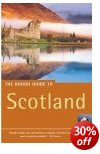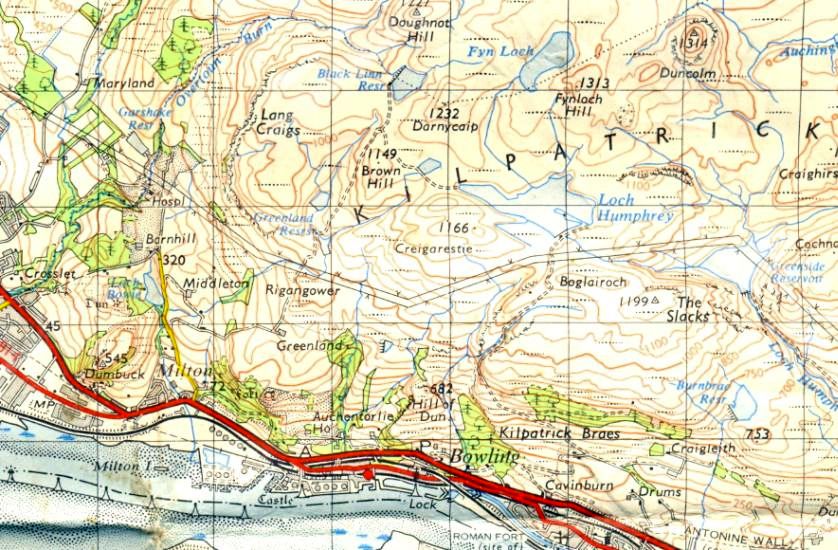  |
Kilpatrick HillsMilton Crags
|
  |
Lang
Craigs above Milton
The "Crags Route" is a circular, signposted walk. The
walk yields fine views over Dumbarton, the River Clyde, Loch
Lomond and Ben Lomond. The area is a Site of Special Scientific Interest ( SSSI )and home to many rare plants. |
Lang Craigs above Milton from the Southern
Bank of the River Clyde |

Lang Craigs above Dumbarton |
Lang Craigs in the
Kilpatrick Hills from Dumbarton Golf Club |
Lang Craigs in the Kilpatrick
Hills from Levengrove
Park at Dumbarton |
 |
|
Campsie
Fells
from Trig Point on Doughnot Hill |
|
Snow-covered Ben
Lomond
from Lang Craigs |
 Ben
Lomond
from Lang Craigs |
|
Luss
Hills and Loch
Lomond
from Lang Craigs |
|
Lang Craigs
on descent to Overtoun House |
|
Overtoun
House
on descent from Lang Craigs Overtoun House was designed by the Glasgow architect James Smith in the Scottish Baronial style. It was built for the industrialist James White and completed in 1862. |
|
Overtoun
House
on descent from Lang Craigs The Overtoun Estate is located on a hillside overlooking the River Clyde, above the village of Milton and the town of Dumbarton. |
 Overtoun Bridge
|
|
The Gatehouse of Overtoun House
|
 Map of Lang Craigs
in the Kilpatrick Hills |
 Route Map of Lang Craigs
in the Kilpatrick Hills |
 Map of Lang Craigs
in the Kilpatrick Hills |
LANG CRAIGS - ROUTE DESCRIPTION:
 Route Map for
Lang Craigs
in the Kilpatrick Hills |
LANG CRAIGS - ROUTE DESCRIPTION 2:
Location: Dunbartonshlre
Map: Ordnance Survey Landranger 64
Distance: 5 miles / 8km
Time: 2-3 hours
Terrain: Easy woodland walk
Lang Craigs was purchased by the Woodland Trust in 2011.
Starting at the sign along from Overtoun House, a striking mid-19th century building, join the circular path in the direction of the crags.
The track leads up through fields and woodland, with glimpses of the crags on the right, until emerging into a flat grassy clearing.
Various paths lead from the clearing but the circular route crosses directly over and up the opposite slope, from where the first panoramic views of
Lang Craigs can be seen.
The route follows a gently rising curve which runs parallel to the crags on the right and the gorge cut through the landscape by the Overtoun Burn,
unseen but babbling noisily, to the left.
The route is easy to follow but can be slippery in wet conditions.
As the path climbs and follows the hill around to the back of the crags it's a delight to watch the ever-changing scenery, as higher ground
allows for more and more expansive views down to the Clyde and north to the Arrochar Hills and Ben Lomond.
The terrain also changes, shifting between bracken moorland and reedy marsh.
The best-known local landmark, Dumbarton Rock, indulges in a bit of playful hide-and-seek; one moment visible, the next obscured as the route
turns a bend or passes behind a grassy hillock.
As the path approaches the higher slopes it passes through a gap in the deer-fence and leads up into Forestry Commission woods.
The enclosed woods are an immediate contrast to the wide open slopes, but pleasantly so, with birdsong and the sounds of scrunching
pine-needles and twigs cracking underfoot.
A few metres on a sign invites walkers to choose between the continued circular path and the crag-top walk described here.
The circular path continues through the woods, fairly quickly joining a wide forestry track with routes off to near-by Doughnut Hill and Loch Humphrey.
By contrast the first 20 metres or so of the climb to the summit is extremely boggy.
To be sure of at least semi-solid ground it's necessary to stick close to the trees lining the path.
After a short, squelchy scramble through mud and over springy moss the trail emerges into a clearing a short distance from the crag-tops.
Walking along the top there are more spectacular views of the Clyde and the distant mountains.
The scenes below; patchwork farmland ( complete with what looks from this distance, like toy tractors and sheep ), moorland and scattered
woods, both ancient and new, are pretty too.
There's a sturdy fence between the path and the crags most of the way but at times the path nears the drop, allowing for some breath-taking glimpses directly down the
rock-face, and of the trees and scrubs determinedly growing out of the nooks and crannies.
There's more to the walk than impressive views. Between the many varieties of fungi, wild flowers and colourful heathers and
mosses, the overhead cries and caws of buz-aards and crows, and the occasional butterflies and bees buzzing about there's plenty of
wildlife to admire too.
The path finally weaves its way downhill into farmland and towards the forestry wood, meeting the circular path again at the foot of the
hill. It's worth a wee detour from here to visit the two tranquil - and clearly well-stocked - reservoirs just inside the woods.
Soon after the track exits the woods a sign directs walkers to a fenced-off path which passes through the working farmland.
The route runs alongside a burn and Middleton Wood and passes Middleton House in the distance, before joining a track edged with
hedgerows bursting with brambles, rose-hips and the occasional wild reap, and finally meeting the Milton Brae road.
The final, short walk from here back to Overtoun House ( which incidentally has a nice wee tearoom ) is pretty, with colourful, overhanging
trees and continuing views across the farmland to the crags.
Route:
Start and finish at the car park 100m from Overtoun House { GR426762 }.
Turn off the A82 at Milton and continue up the minor road for 2.5km to Overtoun House.
Follow the Lang Craig Circular Path sign up a farm track.
Pass through a gate, cross the clearing and follow the trail round to the far end of the hill behind the crags.
Go through the gap in the fence and follow the sign up into the woods.
Follow the next sign to the crag tops { or alternatively take the lower circular path }.
Walk the length of the crag tops before descending towards the woods next to a stone dyke wall.
Follow the signs along the track towards Milton through a series of farm gates until you reach the wide farm track which curves round to meet Milton Brae.
Take a right to return to the car park a mile along the road.
 :: Clyde River
Walkway
:: Clyde River
Walkway 
Glencoe | Ben Nevis | Knoydart | Isle of Skye | Isle of Arran | The West Highland Way
The Eastern Highlands | The Central Highlands | The Southern Highlands | The NW Highlands